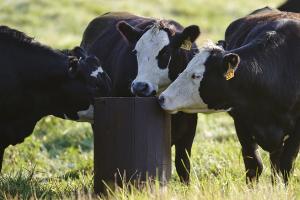
Macrominerals and their importance for cow nutrition
Source: Drovers
Mineral nutrition is vital to overall cow performance. Without an appropriate balance of minerals, cows may not perform as well as expected or could exhibit detrimental effects if the mineral balance is off.
Minerals are divided into two groups based on the quantity of the mineral required by the cow: macrominerals and microminerals (trace minerals). The macrominerals are required as a percent of the diet, while the microminerals or trace minerals are required in ppm (parts per million). This article will discuss macrominerals and a future article will address microminerals.
There are seven macrominerals that need to be analyzed and balanced within a cow’s diet. These are calcium (Ca), phosphorus (P), magnesium (Mg), sulfur (S), sodium (Na), chloride (Cl) and potassium (K). Some of these minerals work together, while others work independently.
Calcium and phosphorus
Calcium and P are two minerals that work hand in hand. These two minerals are the main mineral constituents in bone. In addition to their importance in bone development, Ca is also important in muscle function and P plays key roles in metabolic functions throughout the body. In general, grazing cattle will have adequate Ca in forages, especially legumes such as alfalfa. On the other hand, P can be deficient in these forages and supplemental P is generally needed in forage-based diets, but how much is needed? The key is to sample and test forages to determine mineral content and select a mineral to meet the cow’s needs. It is relatively easy to meet the requirements for Ca and P, but there is also value in ensuring the proper Ca:P ratio. The optimum Ca:P ratio based on extensive research is 1.5:1 to 2:1, but adverse effects are not seen until this ratio reaches 6:1. The requirement for Ca is 0.27% and P is 0.23%.
For a forage-based diet rich in legumes, a high P mineral needs to be provided to ensure the proper Ca:P ratio. In this situation, the P in the mineral supplement should be higher than the Ca. For instance, the feed tag on the mineral might be 8% Ca and 12% P.
If concentrates, in particular distillers grains plus solubles, are used in the ration, the Ca:P ratio can be within the acceptable range, as grains and distillers grains are high in P and low in Ca.
Magnesium
Magnesium is required at 0.2% of the diet for lactating cows and only 0.12% for gestating cows. Magnesium plays a role in enzyme and nervous system function, as well as carbohydrate metabolism. It is critical that cows receive sufficient Mg when they are lactating heavily, especially if they are grazing lush, rapidly growing pastures. This is the time when producers need to be concerned about grass tetany, as the conditions are ideal to cause the metabolic disorder. Oftentimes the pastures that the cattle are grazing in early spring have excess potassium, which inhibits Mg absorption in both the plant and animal. A high Mg mineral (10-14% Mg) should be provided to lactating cows on green grass to help prevent grass tetany. This mineral needs to be consumed at 4 oz per head per day to meet Mg requirements. Adequate salt intake is also important to preventing grass tetany, therefore loose salt should be provided to ensure adequate salt intake.
Sulfur
Sulfur is not typically thought to be necessary in mineral supplements, but conversely it is thought about in terms of how it can cause toxicity. Sulfur is necessary in the diet for the rumen microorganisms to form sulfur-containing amino acids. There are multiple sources of S and some of these can result in toxicity, specifically high sulfate water in western South Dakota. Research conducted at the Cottonwood Range and Livestock Field Station shows that excess sulfates in water can cause polioencephalomalacia (PEM or polio) in cattle. Symptoms include blindness, difficulty walking, muscle tremors, convulsions and ultimately death. Cattle on pasture require 0.15% sulfur, but test forages and water prior to adding supplemental sulfur to a mineral supplement. Another important reason to avoid supplementing excess sulfur is that it interferes with copper and zinc absorption. This will be discussed in more detail in the micromineral article.
Sodium and chloride
Sodium and chloride work together to maintain cellular volume, pH and osmolarity of body fluids. Sodium chloride (NaCl, salt) promotes water intake. Sodium plays a role with K for nutrient transport into and out of cells and Cl is involved primarily in the production of hydrochloric acid production in the abomasum (stomach) to aid in digestion. A 1300 lb cow will consume between 1 and 2 ounces of salt per day to meet requirements.
Potassium
As mentioned previously, K works with Na in the body to regulate osmotic pressure and transport nutrients in and out of cells. As the K levels increase, the Na levels will need to increase equally. Through forage analysis, K levels are adequate in most of western South Dakota and periodically border on toxic, but there are no documented symptoms of K toxicity. With dormant forages it may be necessary to provide a mineral supplement that contains 1% K to remedy any deficiencies, as K will leach out of dormant forages.
Mineral nutrition and balance is key to animal performance and productivity. Take some time to evaluate your mineral program and determine if the mineral supplements you are using are meeting the needs of your cattle. It is often stated that a mineral is formulated for the region, but there can be huge variations in minerals from one side of your ranch to the other. It might be time for you to sample your forages and get a better understanding of what is available to your cows and what you need to provide to them in the form of a supplement.



